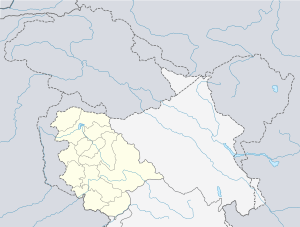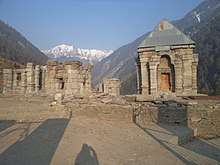Naranag
Naranag (or Nara Nag) is a tourist village[1] of Ganderbal district, Jammu and Kashmir, India. It is located around 8 km from Kangan,[2] 6 km upstream from the Sind River. Noted for its scenic meadows, lakes and mountains, it is a base camp for trekking to the Mount Haramukh 16,870 ft (5,142 metres) and Gangabal Lake. The village lies at the left bank of the Wangath river, which is a tributary of the Sind River.[3] Tourism hut at Naranag for any information and assistance tourism officials are available and hut is also provide for accommodation.
Naranag | |
|---|---|
village | |
 Naranag | |
 Naranag  Naranag | |
| Coordinates: 34°19′31″N 74°56′48″E | |
| Country | India |
| State | Jammu & Kashmir |
| District | Ganderbal |
| Community development block in India | Kangan |
| Elevation | 2,128 m (6,982 ft) |
| Time zone | UTC+5:30 (IST) |
| Postal Index Number | 191202 |
| Vehicle registration | JK16 |
Tourism

The Naranag valley is noted for its scenic meadows.[4] The village is a base camp for trekkers to the Mount Haramukh, the Gangabal Lake and Satsar (the seven lakes).[5][6] It is also a base for the trekkers to Gadsar Lake, the Vishansar Lake and the Krishansar Lake, though it takes 5 to 7 days of trekking.[7]
There are also many other peaks and alpine meadows around the Naranag Valley. In the winters, Naranag receives heavy snowfall, during which skiing is practiced.

Naranag Temple
The Naranag temple is the main attraction for the tourists. It is one of the important archaeological sites of the country.[8] The site consists of a cluster of temples facing each other at a distance of about 200 meters.[9] Historians say that the temple is dedicated to Shiva and was built by Lalitaditya Muktapida, of the Kayastha Naga Karkota Dynasty in the 8th century AD. It is believed that the king Awantivarman paid a visit and donated a pedestal for bathing at Bhutsher.
It is also believed to be dedicated to the ancient Nagas. Hence, the name "Naranag". It was built by the Naga Karkotas, who are said to be Hindu Kashmiri Kayasthas of the Naga sect, known for their reverence of serpents. They used to stay here and do their sadhanas.
Its architecture reveals the art of the 8th century. The government has only constructed walls to protect it from encroachments and nothing else has been done. It is now left in ruins of which only faint traces have survived.[10] This temple has the typical Aryan structure as was present in Aryan Kashmir.[11]
See also
References
- "Trekking !! Naranag , Gangabal Lake and Kangan in kashmir". travbuddy.com. Retrieved 5 July 2012.
- A E. Ward (1896). The tourist's and--sportsman's guide to Kashmir and Ladak, &c. Thacker, Spink. p. 70. Retrieved 13 June 2012.
- M. K. Khera, B. D. Sharma, Majid Husain (1991). Energy Problems and Prospects: Studies on Jammu and Kashmir. Concept Publishing Company, 1991. p. 100. ISBN 9788170220350. Retrieved 5 July 2012.CS1 maint: uses authors parameter (link)
- "Trekking in Kashmir". spectrumtour. Retrieved 13 June 2012.
- "Kashmir trekking". jktourism. Archived from the original on 14 May 2012. Retrieved 13 June 2012.
- Parvéz Dewân (2004). Parvéz Dewân's Jammû, Kashmîr, and Ladâkh: Kashmîr. Manas Publications, 2004. pp. 140, 259, 260. ISBN 9788170491798. Retrieved 5 July 2012.
- "Naranag Gangabal Trek". KashmirTreks.in. Retrieved 2 April 2014.
- Jagdish Saran Sharma (1981). Encyclopaedia Indica, Volume 2. S. Chand, 1981. p. 859. Retrieved 5 July 2012.
- Ramesh Chandra Agrawal (2 September 2008). Kashmir and its monumental glory. Aryan Books International, 1998. pp. 104, 105. ISBN 9788173051074. Retrieved 13 June 2012.
- "Naranag temple in ruins". kashmirmonitor.org. Archived from the original on 4 August 2012. Retrieved 13 June 2012.
- "Ganderbal District Information, Videos , News and Images about Ganderbal District". rtbot.net. Retrieved 7 July 2012.